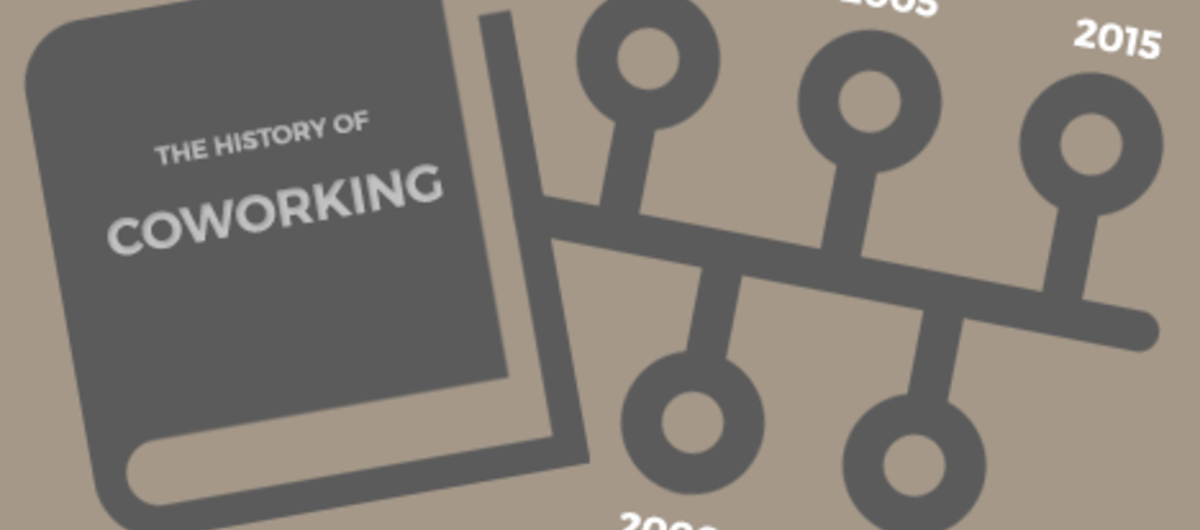2006: The Coworking Wiki started in San Francisco. One of the co-founders was Chris Messina, the guy who created the Twitter Hashtag.
The Hat Factory opened as the first full-time space that was called a “coworking space”. Among the co-founders was Brad Neuberg, Chris Messina and Tara Hunt. It was one out of almost 30 coworking spaces worldwide at this time. Until 2012, its numbers have nearly doubled each year.
The same year, the first “Jellies” started. Jellies are occasional meetings where a small group of people come together to collaborate within an informal atmosphere. Jellies offer the opportunity to exchange ideas, with no commitments or costs. At the same time, they allow a community to build that can eventually lead to the development of an institution like a coworking space.
In reaction to the book "We call it work", an artist came up with the concept of a coworking space called Business Class Net, in 2006. The medium-sized workspace, located in his former gallery in Kreuzberg, finally opened on Labor Day in 2007. It was Berlin’s first coworking space, and also started the first global networks of coworking spaces via fairchise.
2007: For the first time, the term "coworking" was seen as a trend on Google's database. Since then, the search queries increased by factor 20 when searching the word "coworking" prevailed over other search terms. The concept of coworking became a part of mainstream media in the United States. However, until about 2009/2010, the term was restricted only to the United States.
One of the first coworking spaces was bootstrapped. Indyhall developed a coworking space in Philadelphia without having a budget, but by creating a community first. Around 30 people were willing to buy memberships in advance.
In August, the first conference discussing new forms of work, "digital bohemians", took place in Berlin. The meeting was called "9to5". Several of the participants later founded three of the city’s coworking spaces.
Later this year, "Coworking" got its own page on the English version of Wikipedia.
2008: During the South By Southwest (SXSW) in 2008 and 2009, the first unofficial coworking meet-ups took place. Based on these meetings, and the first Coworking Conference in Brussels in 2010, the Loosecubes co-founder Anna Thomas decided in 2011 to organize the first official Coworking Unconference during SXSW. One year later, the GCUC (Global Coworking Unconference Conference) emerged.
In August, the Coworking Visa is born. The program is a voluntary goodwill agreement between many coworking spaces to allow members of other spaces to visit for free.
At Cubes & Crayons, the first coworking space opened alongside facilities for kids ranging from just a few months old to pre-schoolers.
By the end of 2008, there are about 160 coworking spaces worldwide.
2009: The first book on coworking is published. "I'm Outta Here! How coworking is making the office obsolete" is a book about the people & places that kicked off the workplace revolution in the US.
In Germany, Betahaus was one of the first official so-called “coworking spaces”, that opened in March of 2009. No other coworking space had found so often a place in Germany's biggest news magazine, the Spiegel. Because of rising attention, the term "coworking” entered into the German mainstream media. A year later, Germany was established as the first country in Europe to use the term "coworking", according to Google Trends.
2010: The coworking movement celebrated the first #CoworkingDay - in memory of the first "coworking day", which took place five years earlier.
In Europe, the first coworking conference took place at the Hub Brussels. Since then the coworking space has closed, thus the 4th Coworking Europe will take place in Barcelona this year. At the time of the first coworking conference, 600 coworking spaces existed worldwide, with more than half of them in North America.
2011: The year started with the European Jelly Week, organized by Anni Roolf, which became Worldwide Jelly Week only one year later.
The first Coworking Unconference took place in Austin on March 10. A day earlier, NextSpace also announced the first angel funding for a network of coworking spaces.
2011 also saw the first large companies begin to experiment with their own coworking spaces. The result was the coworking space Modul 57, founded by one of Europe's largest tourism companies TUI, with its headquarters in Hanover (Germany). The Bank ING, opened their first coworking space, Network Orange, in Toronto. Steelcase was already using some coworking spaces as a showroom for office furniture of Turnstone. Two years later, they opened Workspring as their own chain of coworking spaces, which specializes in "corporate coworking".
2012: In October, more than 2000 coworking spaces are found worldwide.
Over the course of the year, Twitter users sent 93,000 tweets with the hashtag “coworking” (Source: Topsy).That is a huge increase of 52% compared to the previous year. Considering the search term, with and without hashtag, there were even more than 217,000 tweets (+56%). During GCUC, Coworking Europe and Coworking Spain, Twitter users were chirping about coworking most often.
2013: At the beginning of the year, more than 100,000 people worked at coworking spaces. In July, the 3,000th coworking space opened.
There were now nine networks of coworking spaces that operated in more than five locations, such as The Hub, NextSpace in the US or Urban Station in Latin America. Since 2008, NextSpace collected nearly US$2.5 million for opening new coworking spaces, and has recently taken over Chicago's Coop.
However, the majority of coworking spaces run independently with only one or two locations. Some of them are organized in associations to create more values for their members. Coworking Ontario, for instance, launched the first health insurance plan for coworking spaces in August 2013.
The history is not finished and the movement goes on. For this reason, we created an dynamic timeline, which we will continiously update. If you think there are some facts missing, just let us
:::
The History of Coworking: In A Timeline - with articles, videos, pictures and more.
What is coworking? Read this article.
This article was edited on Dec 14, 2018, adding "Nutopia" to the history of coworking spaces.
:::
Overview to Coworking Resources from A to Z
▶︎ Associations
▶︎ Books
▶︎ Conferences
▶︎ Consultants
▶︎ History
▶︎ Media - blogs & podcasts
▶︎ Tools to manage coworking spaces
▶︎ Statistics - newsletter membership required
▶︎ Visa programs - one membership to access multiple coworking spaces
▶︎ Values







